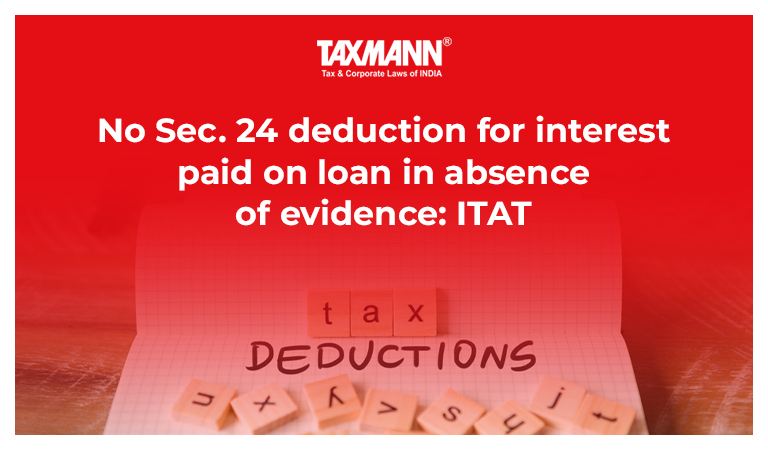No Sec. 24 deduction for interest paid on loan in absence of evidence: ITAT
- Blog|News|Income Tax|
- 2 Min Read
- By Taxmann
- |
- Last Updated on 2 June, 2022
Case Details: Netra Software Technologies (P.) Ltd. v. ACIT (CPC) - [2022] 138 taxmann.com 309 (Bangalore-Trib.)
Judiciary and Counsel Details
-
- Chandra Poojari, Accountant Member & Smt. Beena Pillai, Judicial Member
- Smt. Sheetal Borkar, Adv. for the Appellant.
- Smt. Priyadarshini Mishra, Addl. CIT (DR) for the Respondent.
Facts of the Case
Assessee-company filed a loss return for the Assessment Year 2011-12. Later, it revised the return to claim deduction of interest paid on loan taken for construction of commercial proper. The deduction was claimed under section 24 while computing loss under the head ‘income from house property.
While processing the return, the CPC reduced the claim of loss by disallowing deduction towards interest. The order of CPC was further confirmed by the CIT(A). Aggrieved-assessee filed the instant appeal before the Tribunal.
ITAT Held
The Tribunal held that the assessee claimed interest on loan borrowed for the purpose of construction of the commercial building. The assessee claimed that building construction had been completed and it was ready to let out and the assessee always had the intention to let out the property.
However, due to market conditions, the assessee failed to let out and failure to let out cannot be attributable to the assessee.
It should be noted that the assessee had not placed any iota of evidence to suggest that the commercial building was ready to let out and the assessee had taken any steps to let it out. Unless and until the building is ready to let out, the interest incurred by the assessee on the loan borrowed for the construction of the building has to be capitalized.
There was no evidence to suggest that the commercial building was ready in all respects by getting the power connection, water connection, occupation certificate, clearance from the fire fighting department, etc. Thus, it cannot be presumed that the building was ready to let out and the assessee had taken any steps to let out.
The whole plea of the assessee to let out the property was only on the presumption basis without any specific evidence on record to suggest that the assessee had taken steps to let out the property. Accordingly, the lower authorities were justified in disallowing the claim of the assessee with regard to interest borrowed on loan used for construction of building.
List of Cases Referred to
-
- Ms. Priyananki Singh Sood v. Asstt. CIT [2019] 101 taxmann.com 45/174 ITD 371 (Delhi – Trib.) (para 4).
Disclaimer: The content/information published on the website is only for general information of the user and shall not be construed as legal advice. While the Taxmann has exercised reasonable efforts to ensure the veracity of information/content published, Taxmann shall be under no liability in any manner whatsoever for incorrect information, if any.

Taxmann Publications has a dedicated in-house Research & Editorial Team. This team consists of a team of Chartered Accountants, Company Secretaries, and Lawyers. This team works under the guidance and supervision of editor-in-chief Mr Rakesh Bhargava.
The Research and Editorial Team is responsible for developing reliable and accurate content for the readers. The team follows the six-sigma approach to achieve the benchmark of zero error in its publications and research platforms. The team ensures that the following publication guidelines are thoroughly followed while developing the content:
- The statutory material is obtained only from the authorized and reliable sources
- All the latest developments in the judicial and legislative fields are covered
- Prepare the analytical write-ups on current, controversial, and important issues to help the readers to understand the concept and its implications
- Every content published by Taxmann is complete, accurate and lucid
- All evidence-based statements are supported with proper reference to Section, Circular No., Notification No. or citations
- The golden rules of grammar, style and consistency are thoroughly followed
- Font and size that’s easy to read and remain consistent across all imprint and digital publications are applied








 CA | CS | CMA
CA | CS | CMA


